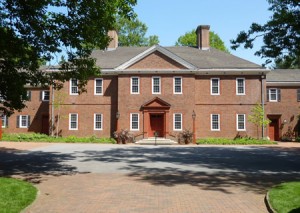 The other day we drove to Mount Cuba, a horticultural center in Delaware. The forest garden is part of an estate built in the 1930s by Lammot du Pont Copeland and his wife Pamela, a branch of the mighty Delaware family. We went to look at the trillium garden, but I was also impressed by the house, a very large Colonial Revival mansion that was completed in 1937. The beautiful brick architecture was exquisite, simple to the point of distillation. The design was the work of Victorine and Samuel Homsey. Samuel (1904-1994), a native of Boston, graduated from MIT and met and married Victorine du Pont (1900-98), who had studied at the Cambridge School of Domestic and Landscape Architecture for Women. They set up shop in Delaware, which is where Victorine had family contacts; theirs was probably the first husband-and-wife practice in the United States. In addition to Mount Cuba they were responsible for several building on the nearby Du Pont estate, Winterthur, as well as the Delaware Art Museum. The Museum of Modern Art selected their house design to represent the International Style for the 1938 Paris Exhibition, but they were not modernist converts. “We certainly are not modern if that means following worshipfully the so called functional or international style,” wrote Victorine. “Nor do we follow with blind admiration the great designers of earlier periods. We try to work out each job as a totally separate problem and to divorce from our minds any preconceived idea of style.” Eclecticism is maligned today, but looking at Mount Cuba one can only admire its rigor and sense of conviction.
The other day we drove to Mount Cuba, a horticultural center in Delaware. The forest garden is part of an estate built in the 1930s by Lammot du Pont Copeland and his wife Pamela, a branch of the mighty Delaware family. We went to look at the trillium garden, but I was also impressed by the house, a very large Colonial Revival mansion that was completed in 1937. The beautiful brick architecture was exquisite, simple to the point of distillation. The design was the work of Victorine and Samuel Homsey. Samuel (1904-1994), a native of Boston, graduated from MIT and met and married Victorine du Pont (1900-98), who had studied at the Cambridge School of Domestic and Landscape Architecture for Women. They set up shop in Delaware, which is where Victorine had family contacts; theirs was probably the first husband-and-wife practice in the United States. In addition to Mount Cuba they were responsible for several building on the nearby Du Pont estate, Winterthur, as well as the Delaware Art Museum. The Museum of Modern Art selected their house design to represent the International Style for the 1938 Paris Exhibition, but they were not modernist converts. “We certainly are not modern if that means following worshipfully the so called functional or international style,” wrote Victorine. “Nor do we follow with blind admiration the great designers of earlier periods. We try to work out each job as a totally separate problem and to divorce from our minds any preconceived idea of style.” Eclecticism is maligned today, but looking at Mount Cuba one can only admire its rigor and sense of conviction.


Mount Cuba looks peaceful, wholesome, and permanent. The kind of place one can imagine countless future generations enjoying. It is a lovely building to see.